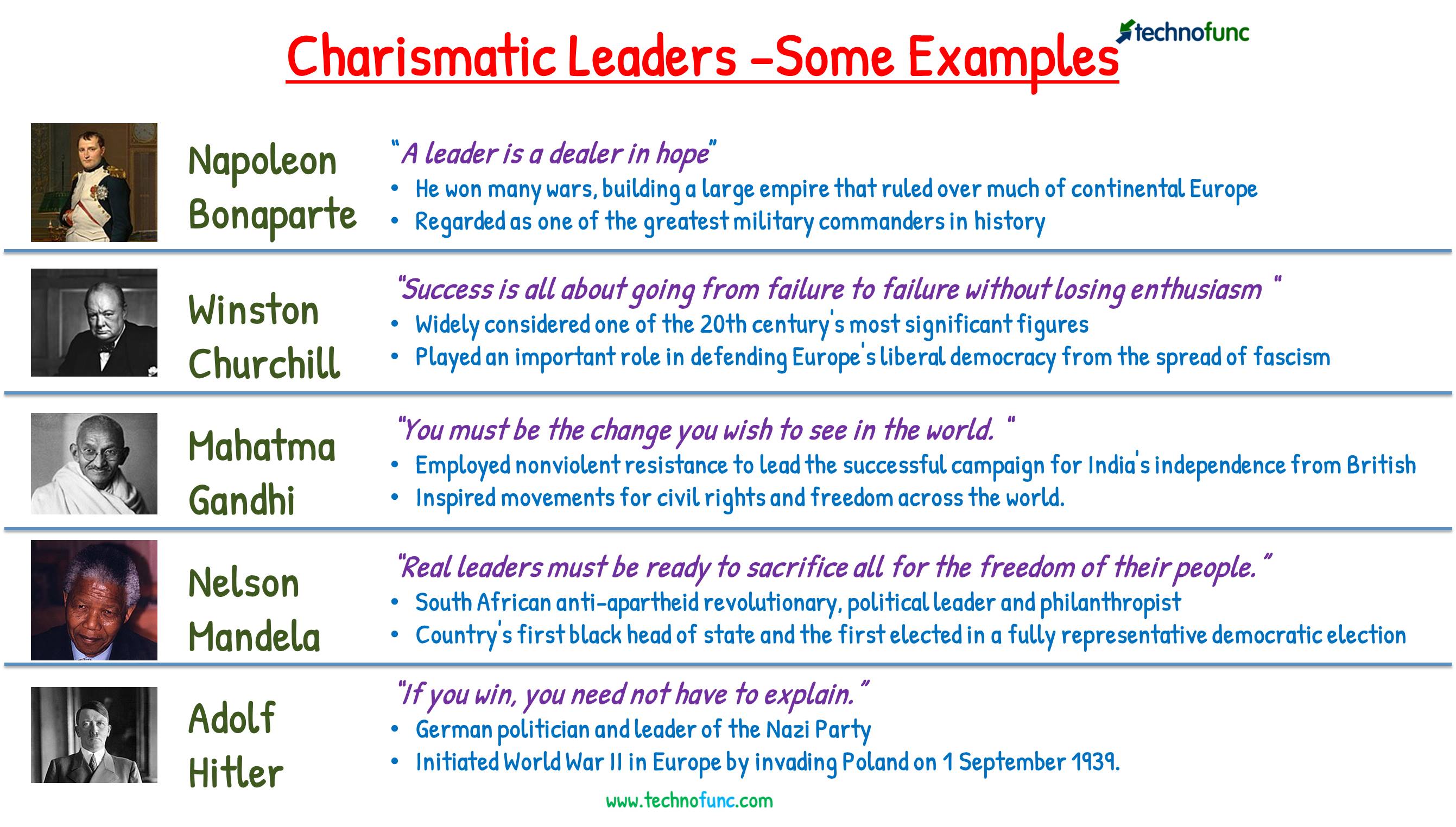- Home
- Business Processes
- Industry Knowledge
- Aerospace Industry
- Automotive Industry
- Banking Domain
- BFSI Industry
- Consumer/ FMCG Industry
- Chemicals Industry
- Engineering & Construction
- Energy Industry
- Education Domain
- Finance Domain
- Hospitality Domain
- Healthcare Industry
- Insurance Domain
- Retail Industry
- Travel and Tourism Domain
- Telecom Industry
- Leadership Skills
- eLearning
- Home
- Leadership Skills
- Leadership Theories
- Charismatic Theory
Charismatic Theory
Charismatic leadership is a trait-based leadership theory where the leaders act as visionary driven by their convictions and motivate their followers to work towards common vision using their charm and persuasiveness. These charismatic leaders act as role models and exhibit extraordinary characteristics that inspire devotion and motivation in followers to persuade change. Leaders are able to cultivate a profound sense of trust with the group of followers.
Charisma has been associated with leadership for centuries, and defined as 'a divinely conferred power or talent'. It was first formalized as a leadership theory by House in 1976, following the work of Weber, an early sociologist, in the 1940s.
The Theory of Charismatic Leadership
During the first decade of the 2000s, the trait approach of leadership gained new interest through the current emphasis given by many researchers to visionary and charismatic leadership.
Charismatic leadership came to the forefront of public attention during the 2008 US elections when Barack Obama was elected as the first African American president. He is believed to be charismatic, among many other leadership attributes he demonstrates.
The trait approach began with an emphasis on identifying the qualities of great persons, shifted to include the impact of situations on leadership, and, currently, has shifted back to reemphasize the critical role of traits in effective leadership. Max Weber defined the term “charisma” as, “charisma is applied to a certain quality of an individual personality by virtue of which he is set apart from ordinary men and treated as endowed with supernatural, superhuman, exceptional powers or qualities”.
Characteristics of Charismatic Leadership
Charismatic leaders are regarded as of divine origin and the recognition of the followers depends upon the demonstration of constant proof, which in turn, augments follower devotion and enthusiasm. Given below are the characteristics of Charismatic Leadership, what distinguishes charismatic leaders from others:
- Charismatic leaders have a special charm and glow
- They have a natural charisma that draws people to them
- A charismatic leader is good at recognizing the emotions and moods of others
- They effortlessly work with people and make everyone feel important and valued
- Charismatic leaders consistently possess traits of self-monitoring
- They constantly engage in impression and perception management
- They are motivated individuals who pursue attaining social power
- They have strong motivation to attain self-actualization
- They are good at motivating others and use the right word or action to uplift the team’s spirit
- They use these gifts to maintain power and control over the group
Five Charismatic Types
Dubrin, classified Charismatic leaders into 5 types, viz. socialized, personalized, office-holder, personal, and divine charismatic, which are discussed below:
1. Socialized Charismatics:
A socialized charismatic is a leader who uses power only for the benefit of others, rather than using it for private gains. Socialized charismatic leadership (SCL) is a type of leadership characterized by a leader’s altruistic intent and helping others internalizes his or her values. Socialized charismatic leaders are thought to play an ethical leadership role. The socialized charismatic formulates and pursues goals that fulfill the needs of group members and provide intellectual stimulation to them. Followers of socialized charismatics are autonomous, empowered, and responsible.
2. Personalized Charismatics:
Personalized charismatics are leaders who use the powers to a certain extent for personal gains, to serve their own interests. The personalized charismatic leaders have vested interest agenda, characterized by high authoritarianism, high narcissism, self-aggrandizing, and non-egalitarian. Such leaders impose self-serving goals and they offer support to group members only when it facilitates their own goals. They are exploitative leaders who wish to accumulate power by imposing self-serving goals. Followers of this type of leader are typically obedient, submissive, and dependent;
3. Office-holder Charismatics:
For this type of leader, charismatic leadership is more about the office occupied by him/her rather than his/her personal characteristics. By being a holder of a key position, the leaders attain high status. Leaders in a large bureaucratic organization can use their authority and the power associated with the position. Most managers we find in organizations lack charisma. They are bland personalities, the person you never remember, who has nothing of interest to focus on. They are the people we forget since they can never get anyone excited about what they are doing.
4. Personal Charismatics:
A leader with this quality often gains very high esteem through the extent to which others have faith in them as people. Personal charisma is when someone has very high amounts of sophisticated social and emotional skills. Irrespective of the high or low status held by this leader, the personal charismatics are able to influence the followers, through their right traits, behaviors, and characteristics.
5. Divine Charismatics:
A historically important type of charismatic leader is that of the divine charismatic. Middle English also adopted the word as "karisme" to refer to gifts of healing and teaching. Such leaders tend to have divine grace and they are considered as magnetic savior, who would arise to lead people through a crisis. The divine charismatic leaders are the ones where people think that they are god sent.
Quotes on Charisma
Charisma appears to be extremely powerful to influence people, but it is difficult to define and learn. Given below are a number of different charismatic definitions:
"Throw away those books and cassettes on inspirational leadership. Send those consultants packing. Know your job, set a good example for the people under you, and put results over politics. That's all the charisma you'll really need to succeed. Do You Need Charisma?
Dyan Machan
"We need less posturing and more genuine charisma. Charisma was originally a religious term, meaning "of the spirit" or "inspired." It's about a sparkle in people that money can't buy. It's invisible energy with visible effects."
Marianne Williamson
"You have got charisma! Becca!: Hats that? It's a special quality of leadership that captures the popular imagination and inspires allegiance and devotion."
Crawl (Movie: Son in Law, 1993)
"Charisma is a fancy name given to the knack of giving people your full attention."
Robert Brault
I mean, my first impression, and they're rarely wrong, is that you have none of the qualities that we normally seek in a prospective flat-mate.'I talking here about things like presence, charisma, style and charm, and I don't think were asking too much, I don't think were being unreasonable."
Alex Law (Movie: Shallow Grave, 1994)
"Charm is charisma in the lady."
M. Johannsen.
"Most of us have known leaders at work, in the community, in government, who capture our imagination with a passion for an idea – a vision of the way the future could be. When they speak, we find ourselves mesmerized by their words and drawn by their sense of urgency. They seem to possess a certain indescribable energy that inspires and motivates. They appear to touch our emotions more than our rational mind. Things happen when they are around. There is change. And often we find ourselves, quite willingly, drawn to them. We may also find ourselves performing beyond our expectations to accomplish their goals. Most of all, we are moved by them – and, quite frequently, moved to follow them. What is at the core of their power? Charisma is one word that comes to mind."
DC Benson - 2012

Who is a charismatic leader example?
Napoleon Bonaparte, Winston Churchill, Mahatma Gandhi, Adolf Hitler & Nelson Mandela are some examples of Charismatic leaders from the recent past. They all had a huge following and were able to influence a large section of society to bring out positive change. These charismatic leaders carried great responsibility and showcased a long-term commitment to their values and vision, in which they fully believed in.
Who developed the charismatic leadership theory?
Charisma has been associated with leadership for centuries, and defined as 'a divinely conferred power or talent'. It was first formalized as a leadership theory by House in 1976, following the work of Weber, an early sociologist, in the 1940s. Charismatic authority is a concept of leadership developed by the German sociologist Max Weber. It involves a type of organization or a type of leadership in which authority derives from the charisma of the leader. This stands in contrast to two other types of authority: legal authority and traditional authority.
What is charismatic leadership and how does it work?
Conger highlights five attributes of the charismatic leader. Charismatic leaders are very good at articulating their thoughts and can formulate a vision and motivate others to follow it. They are sensitive to the environment as well as the member's needs. They are known for performing unconventional behavior and take personal risks to gain authority and power.
Is a charismatic leader positive or negative?
Charismatic leaders motivate followers to get things done or improve the way certain things are done. They are able to paint a compelling vision of the future, generate high levels of excitement and initiative, and build strong emotional attachments among followers. This excitement and commitment from teams is very important and brings enormous benefit for the leader and the organization. One the other hand because of the admiration of their “gifted” leaders, followers might be less likely to speak up against the ideas and the propositions of their leader and refrain from offering criticism regarding certain actions or practices.
Why is charismatic leadership important?
Charismatic leadership is a special leadership style commonly often associated with transformational leadership. All transformational leaders need a bit of charisma but they need not need the charismatic leadership style. If someone wants to be a great leader, he needs to work towards gaining the trust of the followers. Charismatic Leadership inspires enthusiasm in their teams and is energetic in motivating others to move forward. This excitement and commitment from teams is very important and brings enormous benefit for the leader and the organization.
What is the dark side of charismatic leadership?
The difference between charismatic leaders and transformational leaders lies in their intention. Transformational leaders want to transform their teams and organizations whereas charismatic leaders may be self-centered focused on their individual priorities rather than the organizational. They may be often focused on themselves, and may not want to change anything.
Why is charismatic leadership bad?
The downside to charismatic leaders is that charismatic leaders can believe more in themselves than in their teams. This can create the risk that a project or even an entire organization might collapse if the leader leaves. A charismatic leader might believe that she can do no wrong, even when others are warning her about the path she's on; this feeling of invincibility can ruin a team or an organization.
Why is charisma attractive?
A charismatic leadership style can resemble transformational leadership because these leaders motivate, persuade, and inspire change in a company. Also, in the followers' eyes, success is directly connected to the presence of the charismatic leader. As such, charismatic leadership carries great responsibility, and it needs a long-term commitment from the leader.
Related Links
You May Also Like
-
McClelland's Theory of Needs is a human motivation theory which states that an individual's specific needs are acquired over time through our culture and life experiences. As per the three needs theory, these acquired needs significantly influence the behavior of an individual. The three main driving motivators are the needs for achievement, affiliation, and power.
-
Hawthorne Studies - Leadership
The Hawthorne studies were conducted on workers at the Hawthorne plant of the Western Electric Company by Elton Mayo and Fritz Roethlisberger in the 1920s. This study established the behavioral change that happened due to an awareness of being observed, resulting in active compliance with the supposed wishes of researchers, because of special attention received, or positive response to the stimulus being introduced.
-
The open systems model of leadership acknowledges the influence of the environment on organizations. An open system regularly exchanges feedback with its external environment. The environment also provides key resources that are necessary to sustain and lead to change and survival. Leadership in an open system should focus on influence, open communication, and patterns to control expanding the number of variables created by external dynamics.
-
Bass's Transformational Leadership Theory
Bass Transformational Leadership Theory is based on performance beyond expectations approach which defines four elements of transformational leadership. The 4 elements described by Bernard A. Bass in 1985 are Idealised Influence, Intellectual Stimulation, Individualised Consideration, and Inspirational Motivation. This study highlights four key insights about performance beyond expectations and associated criteria to measure it.
-
Maslow's hierarchy of needs is a motivational theory that explains that people are motivated by five basic categories of human needs. These needs are physiological, safety, love and belonging, esteem, and self-actualization. There is a little scientific basis for this concept of a hierarchy of needs.
-
The Path-Goal theory defines the characteristics of followers and organizational context and the corresponding leadership style best suited to these factors. A leader should adapt to a behavior that is most relevant for a given employee and work environment mix to achieve a goal. The application of theory drives increased employees' motivation, empowerment, and satisfaction resulting in increased productivity.
-
Process & Stages of Creativity
Creative ideas do not come just like that. There is a process to it. There are a number of techniques of creativity to support the generation of ideas but the widely practiced ones are brainstorming and lateral thinking. Most innovations are not so much the product of sudden insights as they are the result of a conscious process that often goes through multiple stages. The creative process can be divided into four stages of preparation, incubation, evaluation, and implementation.
-
Substitutes for leadership theory is based on understanding the context within which leadership occurs. Different situational factors can enhance, neutralize, or substitute for leader behaviors like under certain circumstances, situational factors may substitute for leadership. These substitutes are of two types - substitutes and neutralizers. Substitutes take away from the leader's power and help group members increase their performance. Neutralizers only remove influence from the leader.
-
The two-factor theory also known as Herzberg's motivation-hygiene theory and dual-factor theory. This motivator-hygiene theory states that certain factors cause job satisfaction whereas certain separate factors cause dissatisfaction in the workplace. An organization can adjust these factors to influence motivation. These factors are respectively termed as motivators and hygiene factors.
-
Participative Leadership Theories
Participative leadership theories rely on the involvement of different participants and suggest that the ideal leadership style is one that takes the inputs of others into account. Participative leaders encourage participation and contributions from group members and involve them in the decision-making process. Participative leadership tries to achieve through people, teamwork and collaboration.
Explore Our Free Training Articles or
Sign Up to Start With Our eLearning Courses

About Us
Learning
© 2023 TechnoFunc, All Rights Reserved










